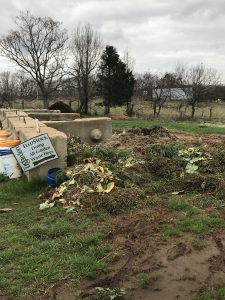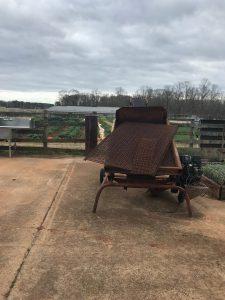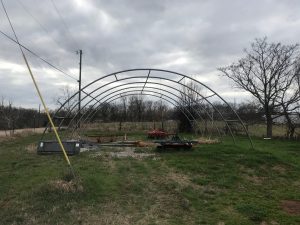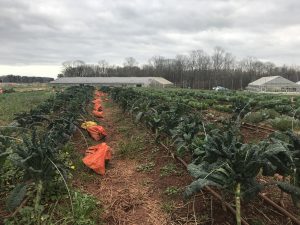- In this picture, you can see UGArden’s compost pile and the barriers they use to divide the various stages.
- One of the most striking things about this picture is the size of the compost pile. It’s much more spread out and larger than I initially expected it to be. The pile that can be seen at the front of the photo is only the first step in the composting process. Once the first pile has been churned up and properly composted it moves to the next barrier and stays there for a while.
- I think if someone saw this picture, they may be able to recognize it as a compost pile. However, they may not know all the other steps that will be involved in the process. Before visiting, I just assumed that you leave the compost in one large pile like the one seen in the photo. I had no idea it had to be moved around and put in different stages.
- When I look at this picture, I feel proud of all the innovation that UGArden has accomplished. Those barriers seen in the photo were once barriers for the Air Force building. Now, they serve as a backboard to help scoop up the compost more easily, as well as prevent rain from running downhill and dampening the compost piles.
- I think this picture is about the amount of work and time that really goes into composting. The various stages barricades help show just how many different stages of decomposition a pile of compost must go through before it’s actually ready to be used. It also shows just how many different things can be composted. The pile is full of a wide variety of scraps and plants.
Tag: UGArden
UGArden – Delaney Williams
The picture’s focus is on an old compost sifter the has been donated to the UGArden from back when UGA first started it’s composting initiative. Different size screens are perched atop the sifter in preparation for future use. In the background are rows of vegetables, and the mushroom greenhouses sit at the bottom of the hill.
One aspect of the picture that really struck me, and about the farm in general, is how worn and home-made everything on the farm seemed to be. While the professor assured us the sifter was in perfect working condition and seemed overall extremely excited about its possibilities, it was clear that the simple piece of machinery doesn’t compare to the main composting center’s setup. In regards to the composting pile, it is obviously not as professional as the professor would like it to be, but the lack of understanding and funding has not dampened his passion for the subject.
The image makes me wonder about the accessibility of composting on campus would really look like. Even with such a jury-rigged setup, there is a process that must be followed and I wonder if students would really be open to composting. I also wonder what students would see when viewing the sifter, and if they would be interested in going farther than just saying oh there’s a rusted piece of farm equipment.
When I look at the picture, I remember seeing the obvious care and pride that the professor has for the farm. Even though some of the fields seemed a little messy, it was clear that everyone who volunteers at the UGArden holds and obvious pride for the work they are doing and it showed in every aspect of the tour.
I think this picture encompasses what UGArden hopes to achieve on campus. They have found a way to start working towards an environmentally friendly goal utilizing every aspect of the farm that they can, which is absolutely admirable. I also think about how much they could achieve if they were able to spread their message farther, or if they had proper funding.
Overall, I really enjoyed our visit to the UGArden and I might look into volunteering in the near future.
UGArden: Promoting Growth by Limiting Moisture
- In this picture there is a cloudy sky over dead trees and grass that is green in some spots and dead in others. Power lines stand to the left while some unknown equipment stands underneath the tunnels.
- I was surprised first at the lack of visible plant-life. That is to say, the fantasized notion of a garden promises fruits and vegetables that are always visible. Of course that isn’t true and logically I must’ve known that, but the subconscious expectations were subverted.
- Initially, looking at this picture, one may see the tunnel as an arch meant to give support to vine-based plants or others that cannot support themselves. I personally thought so on first look, thinking back to a similar arch that leads to my front door at home.
- Looking at this picture, I’m surprised at the amount of knowledge that is in the world that I may never know. Within the world of gardening, there is so much scientific knowledge that ranges across many disciplines. Presumably, every field requires such in depth knowledge, which seem daunting.
- This picture, I think, shows the disconnect between expectation and reality that many people have when it comes to farming and things they don’t know about in general. The tunnel in the picture is actually used to keep moisture of plants, allowing moisture regulation to prevent the growth of mold and other diseases. To an extent, this is a counterproductive method of gardening, as rain should theoretically promote the most amount of growth!
UGArden
In this picture, I see hard work and care. I loved looking at the rows of vegetables and herbs extending out into the field because I knew there was so much below the surface and behind the scenes. Looking at the crops made me think a lot about where our food comes from and how it is made. Most of the time, our food comes from something frozen, or it has been manipulated in a factory. The vegetables in the photo have only been touched by human hands and exist under the rain, sun, and stars. I was struck with such a contrast of the wholesome life and growth of the produce on the UGArden versus the hormone-injected items that sit under a fluorescent light at the grocery store. When I look down the rows of sprouting green stems of leafy bushes, I think about the volunteers and others who took the time to plant and cultivate that seed to develop the plant before me. Growing anything takes time and care, and that effort was evident at the UGArden. I think people will see this effort as well when they see this image, and I hope they too will contemplate the origins of what we eat and how organic and natural what we eat can be. When I look at this picture, I feel excited about our capacity as cultivators. With a little help and guidance, we can grow our own food and sustain ourselves using the tools of the Earth. Ultimately, I think this picture is about the beautiful manifestations of natural life and how that pertains to us. We can be a part of it and perpetuate it to glean the organic material like that of the UGArden





